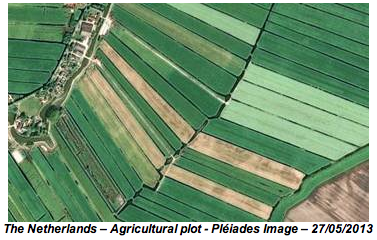SPOT 6, the high-resolution Earth observation satellite designed, built and operated by Astrium, Europe’s space technology company, has now been qualified by the JRC to take part in the MARS-CAP program. MARS-CAP is a program run by the European Commission which involves surveying agricultural land by satellite, as part of the Common Agricultural Policy (CAP).
Following qualification, SPOT 6 joined the other Astrium-operated satellites, SPOT 5, Pléiades 1A and Pléiades 1B, on the program on July 1, as part of the 2013 MARS-CAP campaign. Initiated by the European Union in 1993, the MARS-CAP campaigns involve mapping agricultural land throughout Europe to verify declarations relating to cultivated land areas and fallow land submitted by farmers. The European subsidies granted to farmers are based on these declarations and their verification.
“Astrium Services has been working alongside the European Commission for 20 years to help implement the Common Agricultural Policy,” said Evert Dudok, CEO of Astrium Services. “With these newly-qualified satellites, the constellation operated by Astrium Services will now provide a significantly greater volume of images. Pléiades, SPOT 6 and soon, SPOT 7 will cover a surface area of up to 7 million square km per day, which is almost twice the surface area of the entire European Union!”

In less than a year, the JRC qualified the three new satellites operated by Astrium Services for MARS-CAP. SPOT 6, Pléiades 1A and Pléiades 1B are now contributing to the MARS-CAP program campaigns. This new-generation satellite constellation considerably boosts the image acquisition rate, despite the very specific demands of agricultural sector customers (the image acquisition schedule is extremely precise but sometimes requires last-minute changes, especially due to weather conditions). The satellites’ agility enabling flexibility and reactivity means they can provide an unprecedented level of performance even when programming schedules are updated several times a day as a result of weather forecasts.
SPOT 6 brings new performance levels to the MARS-CAP programme, including heightened resolution (1.5 meterk), the blue spectral band (to acquire images directly in natural colors), enhanced localisation of images and unequalled agility, enabling extensive areas to be mapped in record time.
Pléiades 1A has been in use since November 2012 and Pléiades 1B since May 2013. Very high-resolution acquisitions are particularly useful for smaller and denser plots. At the end of June 2013, 94% of requested surface areas had already been acquired.
Previously, the SPOT 4 and SPOT 5 satellites had provided almost all of the images requested by the European Union each year.

